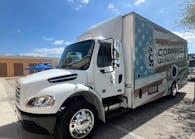Every customer a mobile tool distributor encounters on the route will surely have a variety of power tools in his or her toolbox.
There is a continued need for power tools in the shop – whether that be air-powered or battery-powered products.
Whether it’s replacing an existing tool, or looking to purchase a product he or she has not used in the past, customers consider many factors when it comes to what and how they purchase power tools. Because of this, it’s important to educate yourself on the different applications for power tools, understanding some key differences in cordless and pneumatic tools, as well as the up-and-coming trends in this tool category.
Beth Bjorlo, Global Portfolio Leader, Vehicle Service Power Tools, Ingersoll Rand, says there are three key items technicians consider when purchasing a power tool: application, how the tool will be powered, and safety.
“(Technicians) want to look at the cost of the overall purchase, and durability and reliability of the tool. If they’re making an investment, they want the tool to last a long time,” says Bjorlo.
All about application
When technicians decide what tool to purchase, they first consider how the tool will be used.
The most common power tool purchase for an automotive repair shop technician - regardless of power source - is the 3/8” impact gun. This item is typically used for quick removal and installation of bolts and fasteners anywhere on the vehicle. The second most common tools include the 1/4” and 3/8” ratchets, which are used to access fasteners located in tighter areas - such as under the dash.
However, it is also important to understand the different job requirements of your customers. As an example, Texas-based Mac Tools distributor Chris Carlson has a concentrated mobile technician base. Many of his customers are field techs that work in the oil industry.
With a route in Midland County, Carlson’s customer base is made up of heavy equipment shops who service oil fields in west-central Texas. He has noticed a major increase in cordless tool adoption, due to the nature of his customers’ work – specifically with the purchase of 3/8” and 1/2” impact guns and cordless drills. “I do sell some ratchets … and that’s picking up a little more momentum in some equipment shops because guys are realizing in these tight spots it’s kind of nice to zip that thing in there and run nuts and bolts,” says Carlson.
“It’s really convenient for field guys because they don’t have to be right at their service trucks with the air hose and air compressor hooked up. And typically the air compressors on these trucks aren’t as strong as a shop. So they don’t lose power on an air tool versus a cordless tool. It’s a pretty easy sale for me because I sell on the convenience of not lugging around air tools,” says Carlson.
While field technicians certainly see the value in cordless technology, Mac Tools distributor Shawn Stahle, with a route in Yukon, Oklahoma, confirms he has seen a shift in cordless tool use in repair shops as well.
“A lot of your dealership guys are going to cordless, too. When you walk into a dealership, you don’t hear near the air guns you used to because it’s all cordless technology now,” he says.
While there has been a noticeable shift in the adoption of cordless power tool technology, there is still a need for air tools in the shop.
Pneumatic tools will be used more often for long-term work like polishing and grinding applications, as well as transmission and engine work.
“There are limited effective alternative power source tools for certain product categories such as high-torque impact wrenches, high-horsepower grinders, sanders, cutting tools and air hammers,” says Tony La Neveu, Vice President, Florida Pneumatic.
Comparing pneumatic and cordless options
There are a number of aspects to consider when reviewing both the cordless and pneumatic power tool categories.
Price point
Along with lifetime cost, the upfront cost of pneumatic tools is generally less expensive than their cordless counterparts.
Some distributors confirm younger techs may be more inclined to purchase air tools, due to this relatively lower price point. “I also sell a lot of pneumatic tools to new techs just starting out,” says Salt Lake City, Utah-based Cornwell dealer Scott Harms.
Tool maintenance
Air tools and compressors both need to be oiled regularly for the most efficient operation.
Conversely, the mechanism in cordless tools is self-oiling and does not require additional user maintenance.
Another consideration in terms of maintenance is the regular intervals necessary to charge the cordless tool batteries, in order to operate the tool.
Power used
Another consideration: what power source will be used to operate the tool?
“With a pneumatic you have to have a compressor and an air hose. Besides buying the air tool, you have to have a way for (the air tool) to operate. Where with a cordless tool all you have to do is plug the battery in and go,” says Atlanta-based Cornwell Tools dealer Bob Shaftel.
Many repair shops already have a dedicated air compressor for all technicians to use, requiring only a compressor hose in a strategic location. For cordless tools, they must have the means to recharge the batteries on those tools.
For pneumatic tools, it’s important to know the details of the air supply and compressor output, which can affect how the tool will operate.
“(Distributors) really do need to check the air supply available to the technician, because the compressor size and pipe delivery system does matter on the type of tools the techs can use successfully to their full power,” say experts at SP Air.
Mighty-Seven reps add it’s important to confirm what size air hose is being used and what psi the compressor is set at.
Cordless tools, on the other hand, have two common battery voltage levels available: a lower voltage and higher voltage. The lower voltage range is anywhere from 8V to 14.4V, and the higher voltage range is typically between 18V to 20V, depending on the manufacturer.
“The (repair shop) technicians will buy the 18V and the body shop guys will buy the 12V, because they’re not needing a bunch of power to take panels off,” says Shaftel. “It’s going to be application. I’ll ask ‘How much power do you need?’”
Consider also how long it will take to charge the batteries before they’re operable again. Recharge time can range anywhere from a 30-minute “quick” charging system, compared to standard chargers which may take hours to fully charge the battery. Most professional cordless tools can be recharged in less than 90 minutes.
In addition, the power source affects the weight of the tool.
Because a pneumatic tool is connected to an air hose for power, the tool itself is typically more lightweight than cordless counterparts.
“The battery, being attached to the tool on the cordless side, does add a little bit of weight,” Ingersoll Rand’s Bjorlo confirms. “Whereas the pneumatic side is going to have the hose attached to the compressor, so the power source is not really attached to the tool.”
Power provided
Whether its breakaway and operating torque for impacts and ratchets, or horsepower for grinders, sanders and polishers, users are concerned with the amount of power a power tool actually provides.
“[With] pneumatic tools, the biggest strength is torque and maximum power output. They’re very strong and capable of handling tough applications like taking off tires,” says Bjorlo.
The continually improving “power-to-weight’ ratio is oftentimes touted with power tools, because the composite materials used to build the external housing assist with reducing the weight , “while retaining strength and reliability” of the tool, according to Florida Pneumatic’s La Neveu.
While this lightweighting continues, it’s done without sacrificing power.
“You still need pneumatic tools; there is still a use for them in the shop,” Harms adds. “You can’t use cordless all the time because they’re not quite as strong as a pneumatic tool. New techs need to have pneumatics – they can have both, but pneumatic is probably their first choice.”
One way to gauge the category type a customer may need is with this simple rule of thumb: “If they’re wanting that consistency of torque for hours upon hours, you’re going to go to the air tool line,” Mac Tools’ Stahle says, regarding selling power tools to customers. “If you’re just wanting to zip something off – in and out – and have a quick job, then you’ll go to the cordless line.”
It’s also important to consider the long-term power needed for some applications, as mentioned above.
These applications include grinding and polishing, pulling transmissions, or substantial engine work. Quick torque use includes applications such as lug nut removal and installation, and removal of bolts and fasteners in under hood, under dash and under vehicle work.
Mobility and accessibility
A key benefit often touted for cordless tools is the lack of an air hose, which may limit access or reach of the tool.
“A lot of times these vehicles are getting so much more compact, the air hose is always taking over the vehicle or is in the mechanic’s way, so they have to weigh that factor, too,” says Stahle.
Mobility and access with cordless tools allows technicians to access tighter spaces in the vehicle as well as for field repairs.
“The benefit of cordless versus pneumatic is, you’re mobile, and as long as you’ve got a power source to charge your battery then you’re good to go,” says Shaftel.
As the platform for cordless tools expands, this provides technicians the opportunity to use the same power source for multiple tools.
Conversely, purchasing an air tool does not commit a technician to one particular brand.
“Compressed air is universal, allowing technicians to mix brands to their choice, rather than being tied to a single battery platform for one brand,” says Florida Pneumatic's La Neveu.
The market landscape for cordless and air tools is a bit different, too.
“If they want to go cordless, there are a few options out there. If you’re going to go pneumatic, there are several options out there because of the industry having pneumatics for so many years,” says Shaftel.
Ergonomics and other improvements
Technicians will also consider ergonomics when making a purchasing decision on a tool.
“Is the trigger in the right size for their fingers? Is the grip there? There are continuing advancements from an ergonomic standpoint,” says Bjorlo.
Florida Pneumatic’s La Neveu says there are a number of improvements for air tools, including “advanced designs for internal mufflers to reduce noise levels, (the) use of increased precision parts and bearings to reduce vibration levels, and increased horsepower motors to produce increased power is smaller package size.”
For cordless tools, advancements such as brushless motor technology and continually improving battery performance have aided in the ongoing adoption of this tool type. (See sidebar.)
How to sell the product category
While knowing about the different features of power tools is helpful for selling products, it’s only part of the equation when it comes to ensuring a customer purchase. There are some key things mobile tool distributor can do to up the likelihood of a sale.
Display and demonstrate
First and foremost, distributors must have the tool available in order to sell it to customers.
While having the tool in stock is key, it’s also important to have products out of the box and on display.
Paul Depies, owner of USA Tools in Tampa, Florida, manages 20 tool trucks. He says every truck has both a dedicated cordless tool and separate air tool display.
“We always highlight the cordless tools on the first part of the truck when you come in; we always have a nice display,” says Depies. “For Milwaukee, we’d probably have 10 bare tools on a shelf all nicely lined up. Customers see that right away, and it definitely helps with sales.”
“You’ve got to have them displayed,” adds Carlson, about stocking power tools. “You definitely want an area that’s designated specifically … for cordless tools and for air tools.”
“If it’s out of sight, out of mind, they’re not going to purchase. If you put [the tools] in front of them, they’ll buy it. That’s the biggest thing, is you’ve got to get that product in front of them,” says Stahle.
Along with having the products in stock, be sure to show customers the tool by allowing them to use it. For cordless tools, have the fully charged tools on the truck for customers to grab and use while browsing, and bring the tools into customer shops. For pneumatic tools, consider having a dedicated compressor to hook up tools right on the truck. Or, bring the tools into the shop and allow customers to try them out.
“Get the product in their hand,” says Carlson. “Tell (customers) about the features and that’s about it. They’ll sell themselves.”
And keep the conversation focused on the sale. “You have to talk about product. I do a lot of selling. I focus my conversations more toward that than what they did on the weekend, or that type of thing,” adds Carlson. Carlson says he will also take advantage of promotions available in his flag’s monthly flyer.
Because pneumatic tools have been around for some time, techs have a better understanding of the power and application of these tools. Harms says he doesn’t spend as much time with toting and promoting pneumatic tools, since his customers are already familiar with the product category.
Cordless tools, on the other hand, have been more challenging in some instances to convince a customer to purchase. This is where demonstrations can really aid in the sale.
“With the cordless tool you’ve got to walk in and prove it to them,” says Harms. “A lot of guys are skeptical. Cordless tools you have to walk into the shop. You have to demonstrate them.”
“The older techs seem like they are kind of hard to switch, because they’re so used to pneumatic, that they don’t think the cordless is as good, so they won’t buy it,” he adds.
As an example of customer convincing, Harms says he brought in 1/4” and 3/8” ratchets into a shop. He said many customers were skeptical of the tool size, and power output.
“Then I would sell one to one guy in the shop, and pretty soon every guy in the shop has one,” Harms says. “It takes them a while to catch on.”
Consider selling combo kits
As many mobile tool distributors are aware, some of these air tools and cordless tools are for sale at online retailers and hardware stores. To compete, there are a few approaches distributors can take.
The most obvious is explaining the financing aspect. Truck balances allow customers to purchase high-end professional products by paying down the balance with little or no interest on their truck accounts.
Warranty is another factor. Though some tool manufacturers will cover the warranty directly, a distributor can also handle this after-sale service as a benefit to the customer.
Another consideration, particularly popular with cordless tools, is the option of selling combination kits. Either provided by a warehouse distributor, a flag, or created by the distributor, create a package deal combining multiple tools – say a 1/4” ratchet and die grinder – a tool with an extra battery pack, or a tool with additional accessories; this can be an added incentive to purchase.
The sale can pair a tool the customer is already looking to buy, along with an additional tool they may be interested in, or find use for. Other items that can be paired with a tool include applicable accessories (see sidebar) or gear such as branded apparel.
“They’ll get a deal and extend their portfolio,” says Ingersoll Rand’s Bjorlo. “With combination kits, there’s jobber-friendly packaging. For mobile trucks, we’ll highlight the tool setting, control features, visual pictures of the tool. It talks about the value proposition, so there are many ways we’ll continue to market to make sure everyone has all the information they need to make great purchasing decisions.”



